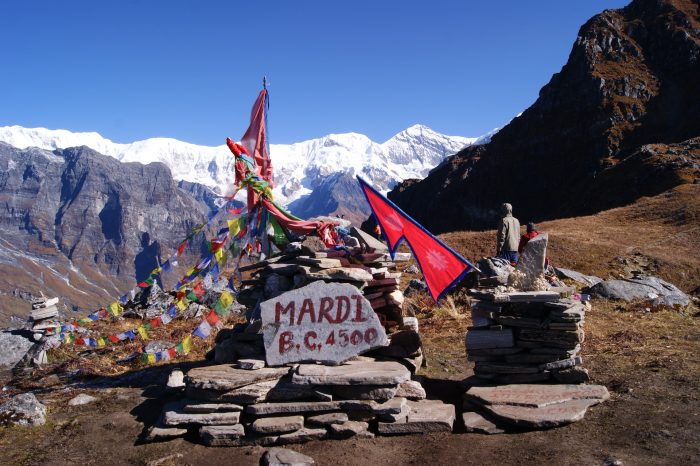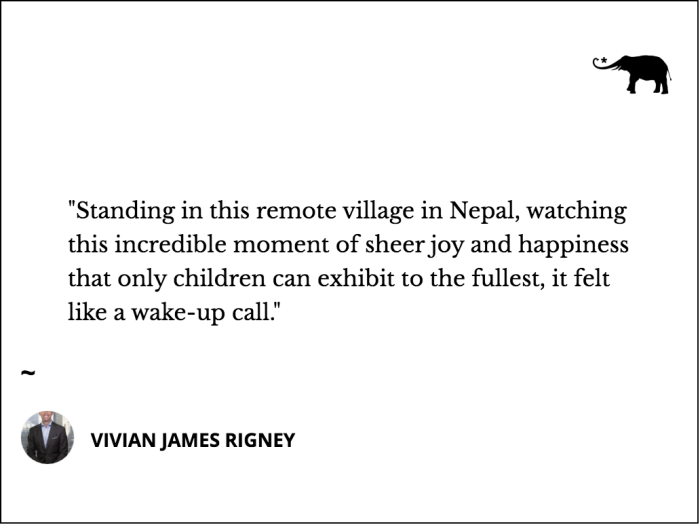The following article is an excerpt from Vivian James Rigney’s book, Naked at the Knife-Edge: What Everest Taught Me About Leadership and the Power of Vulnerability, with permission from Forefront Books, 2022.
We lifted above the city lowlands, weaving our way up into the Himalayas through tight mountain passes and valleys of lush green vegetation.
Despite being a 50-minute assault course of white-knuckle mountain-dodging, the flight felt uneventful. The noise of the engines drowned out everything, and we experienced only a little turbulence as we approached Lukla.
The pilot turned his head and shouted, “Landing in two minutes, pull your seat belts tight!”
I scanned around us for the airport but could see only the sides of the valley, a mix of jagged rocks interspersed with conifer trees close to our left wing. My heart raced. I could almost touch the pinecones. A climber in front of me began blessing herself, her rosary beads spilling off her hands.
Out of nowhere, a tiny, narrow strip of asphalt appeared, revealing a massive cliff at its tip. Suddenly we landed with a huge thud, and I stared at the granite wall rapidly approaching. The pilots pulled the control column back tightly, bringing us to a hard stop just meters from the wall.
When I stepped out of the plane I took a massive breath. It tasted sweet—no more fumes of the city, just the purest of mountain air. For the next 10 days we would be slowly hiking along 65 kilometers (40 miles) of narrow mountain trails through the Khumbu region, where many of Nepal’s most spectacular peaks are located. Surrounded by snowcapped peaks, we would ascend over 2,700 meters of elevation in the process of reaching Everest Base Camp at 5,400 meters (17,700 feet). The reason was clear: we needed to acclimatize.
Air is thinner at higher altitudes; in scientific terms, there are fewer oxygen molecules per volume of air. To compensate for the decrease in oxygen, one of the body’s hormones, erythropoietin (EPO), triggers the production of additional red blood cells to aid in oxygen delivery to the muscles. This process takes time. If we hitched a helicopter ride from Kathmandu to Base Camp, we would likely pass out as our bodies wouldn’t be able to fulfill their need for oxygen. So we’d endure a steady hike through some of the most spectacular mountain scenery in the world to allow science to manifest.
Before we set off, we sorted our gear and sent along our heavier equipment and supplies on the back of yaks to Base Camp. It would be a while until we would see it again. As we started along the trail, the change was stark. We left all asphalt behind and the trail became a windy path through rocks, sand, and gravel—surrounded by tall conifer trees, rhododendron forests, colorful butterflies, and birds. The noise of civilization was replaced by the sound of the afternoon breeze blowing through the pine needles above, surging water running through the steep valley gorge below us, and our own feet as they crunched on the gravel underfoot.
After a couple of hours, we arrived at a small settlement of maybe 10 houses, built of bricks cut from granite and covered with tin roofs. In place of windows were wooden shutters on hinges. Only one of the houses had electricity, and with this, a small TV. People were gathered around inside watching a Bollywood movie, and neighbors leaned in through the open shutters. This house’s TV was a community affair. In the sandy street, three young boys, about four or five years old, teased a puppy with a twig. The puppy was jumping and trying to reach it before they’d pull it up. They were laughing uncontrollably, like they’d just discovered their biggest excitement ever. The puppy was equally excited by all the attention.
I became nostalgic about my own childhood. I remembered days when I would go out to play in the morning and the only rule was to be back home either by dark or dinnertime, whichever came first. My younger brother, Paul, and I, along with our dog, would live through our imaginations in the fields and woods around our Irish home.
In my experiences working with many leaders and executives, they find it hard to look back and relate to their own childhoods, to a time of not knowing and of relishing learning. They have curiosity, but it tends to be highly focused on solving or rationalizing something. I have also noticed that the following two questions usually elicit a long pause from those with children: “What have your kids taught you about yourself?” and “Who are you when you’re with them?”
Coming out of the womb, we are launched into a massive learning curve. The panacea of childhood feeds this unbridled hunger until adulthood, when something else happens. We start to rationalize, summarize, and normalize our experiences, and we begin to entertain judgment around what we know as much as what we don’t know. The latter loses importance over time. With age, we risk losing our openness to learn, and the ego replaces the space to be curious.
It was the opposite in the mountain valleys of Nepal, where adults and children—all generations—were living through shared curiosity mixed with an abundance of humor. Standing in this remote village in Nepal, watching this incredible moment of sheer joy and happiness that only children can exhibit to the fullest, it felt like a wake-up call.
How easy it is to forget that sense of wonder, that sense of being in the pure moment, as if nothing else existed, where time slows down and you can just be. No judgment, no opinion, just wild curiosity and fun. I was beginning a new life in this sacred place—letting go, one step at a time.
~








Read 0 comments and reply